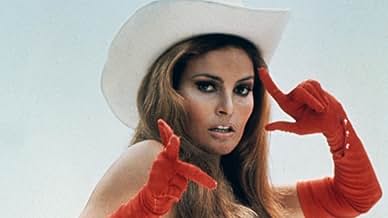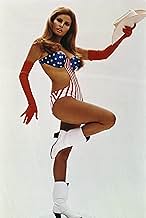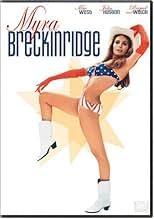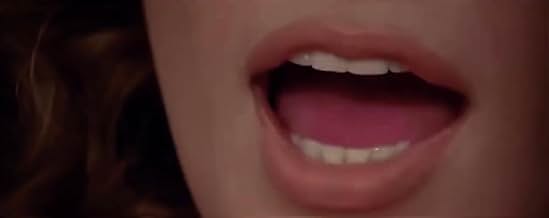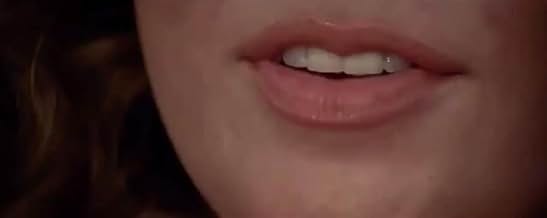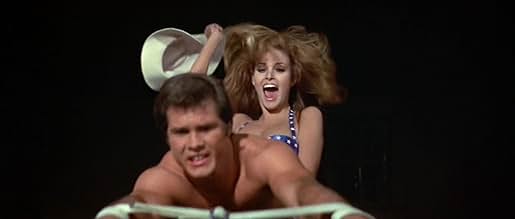VALUTAZIONE IMDb
4,5/10
3646
LA TUA VALUTAZIONE
Dopo aver subito un intervento chirurgico per cambiare sesso, un'aspirante attrice si reca a Hollywood, dove vuole anche rivendicare la proprietà del suo ricco zio.Dopo aver subito un intervento chirurgico per cambiare sesso, un'aspirante attrice si reca a Hollywood, dove vuole anche rivendicare la proprietà del suo ricco zio.Dopo aver subito un intervento chirurgico per cambiare sesso, un'aspirante attrice si reca a Hollywood, dove vuole anche rivendicare la proprietà del suo ricco zio.
- Regia
- Sceneggiatura
- Star
Robert P. Lieb
- Charlie Flager, Sr.
- (as Robert Lieb)
Recensioni in evidenza
Seldom seen since theatrical release in 1970, MYRA BRECKINRIDGE has become a byword for cinematic debacles of legendary proportions. Now at last on DVD in an unexpectedly handsome package, it is as unlikely to win wide audiences today as it was when first released.
Gore Vidal's 1968 bestseller was a darkly satirical statement. Most filmmakers felt that the novel's story, structure, and overall tone would not translate to film, and industry insiders were surprised when 20th Century Fox not only acquired the rights but also hired Vidal to adapt his novel to the screen. But studio executives soon had cold feet: Vidal's adaptations were repeatedly rejected and novice writer-director Michael Sarne was brought in to bring the film to the screen.
Studio executives hoped that Sarne would tap into the youth market they saw as a target for the film, but Sarne proved even more out of synch with the material than the executives themselves. Rewrite upon rewrite followed. The cast, sensing disaster, became increasingly combative. In her DVD commentary, star Raquel Welch says that she seldom had any idea of what Myra's motives were from scene to scene or even within any single scene itself, and that each person involved seemed to be making an entirely different film. In the accompanying "Back Story" documentary, Rex Reed says that MYRA BRECKINRIDGE was a film made by a bunch of people who hid in their dressing rooms while waiting for their lawyers to return their calls.
The accuracy of these comments are demonstrated by the film itself. The basics of Vidal's story are there, but not only has the story been shorn of all broader implications, it seems to have no point in and of itself. Everything runs off in multiple directions, nothing connects, and numerous scenes undercut whatever logic previous scenes might have had. And while director Sarne repeatedly states in his commentary that he wanted to make the film as pure farce, the only laughs generated are accidental.
Chief among these accidents is Mae West. It is true that West is unexpectedly well preserved in appearance and that she had lost none of her way with a one-liner--but there is no getting around the fact that she is in her seventies, and her conviction that she is the still the sexiest trick in shoe leather is extremely unsettling, to say the least. But worse, really, is the fact that West is outside her era. Her efforts to translate herself into a hip and happening persona results in one of the most embarrassing self-caricatures ever seen on film.
The remaining cast is largely wasted. Raquel Welch, a significantly underestimated actress, plays the title role of Myra very much like a Barbie doll on steroids; non-actor Rex Reed is unexpectedly effective in the role of Myron, but the entire role is essentially without point. Only John Huston and cameo players John Carradine, Jim Backus, William Hopper, and Andy Devine emerge relatively unscathed. Yes, it really is the debacle everyone involved in the film feared it would be: fast when it should be slow, slow when it should be fast, relentlessly unfunny from start to finish. It is true that director Sarne does have the occasional inspired idea--as in his use of film clips of everyone from Shirley Temple to Judy Garland to create counterpoint to the action--but by and large, whenever Sarne was presented with a choice of how to do something he seems to have made the wrong one.
The how and why of that is made clear in Sarne's audio commentary. Sarne did not like the novel or, for that matter, the subject matter in general. He did not want to write the screenplay, but he needed the money; he emphatically did not want to direct the film, but he need the money. He makes it very clear that he disliked author Gore Vidal and Rex Reed (at one point he flatly states that Reed "is not a nice person"), and to this day he considers that Vidal and Reed worked in tandem to sabotage the film because he refused to play into their 'homosexual agenda'--which, when you come right down to it, seems to have been their desire that Sarne actually film Vidal's novel rather than his own weirdly imagined take-off on it.
Although he spends a fair amount of commentary time stating that the film is widely liked by the gay community, Sarne never quite seems to understand that the appeal of the film for a gay audience arises from his ridiculously inaccurate depiction of homosexual people. When taken in tandem with the film itself, Sarne emerges as more than a little homophobic--and quite frankly the single worst choice of writers and directors that could have been made for this project.
In addition to the Sarne and Welch commentaries and the making-of documentary, the DVD release includes several trailers and two versions of the film: a "theatrical release" version and a "restored" version. The only difference between the two is that the final scene in the "restored" version has been printed to black and white. The edits made before the film went into general release have not been restored, but the documentary details what they were. The widescreen transfers of both are remarkably good and the sound is quite fine. But to end where I began, this is indeed a film that will most interest film historians, movie buffs, and cult movie fans. I give it three out of five stars for their sake alone, but everyone else should pass it by.
Gary F. Taylor, aka GFT, Amazon Reviewer
Gore Vidal's 1968 bestseller was a darkly satirical statement. Most filmmakers felt that the novel's story, structure, and overall tone would not translate to film, and industry insiders were surprised when 20th Century Fox not only acquired the rights but also hired Vidal to adapt his novel to the screen. But studio executives soon had cold feet: Vidal's adaptations were repeatedly rejected and novice writer-director Michael Sarne was brought in to bring the film to the screen.
Studio executives hoped that Sarne would tap into the youth market they saw as a target for the film, but Sarne proved even more out of synch with the material than the executives themselves. Rewrite upon rewrite followed. The cast, sensing disaster, became increasingly combative. In her DVD commentary, star Raquel Welch says that she seldom had any idea of what Myra's motives were from scene to scene or even within any single scene itself, and that each person involved seemed to be making an entirely different film. In the accompanying "Back Story" documentary, Rex Reed says that MYRA BRECKINRIDGE was a film made by a bunch of people who hid in their dressing rooms while waiting for their lawyers to return their calls.
The accuracy of these comments are demonstrated by the film itself. The basics of Vidal's story are there, but not only has the story been shorn of all broader implications, it seems to have no point in and of itself. Everything runs off in multiple directions, nothing connects, and numerous scenes undercut whatever logic previous scenes might have had. And while director Sarne repeatedly states in his commentary that he wanted to make the film as pure farce, the only laughs generated are accidental.
Chief among these accidents is Mae West. It is true that West is unexpectedly well preserved in appearance and that she had lost none of her way with a one-liner--but there is no getting around the fact that she is in her seventies, and her conviction that she is the still the sexiest trick in shoe leather is extremely unsettling, to say the least. But worse, really, is the fact that West is outside her era. Her efforts to translate herself into a hip and happening persona results in one of the most embarrassing self-caricatures ever seen on film.
The remaining cast is largely wasted. Raquel Welch, a significantly underestimated actress, plays the title role of Myra very much like a Barbie doll on steroids; non-actor Rex Reed is unexpectedly effective in the role of Myron, but the entire role is essentially without point. Only John Huston and cameo players John Carradine, Jim Backus, William Hopper, and Andy Devine emerge relatively unscathed. Yes, it really is the debacle everyone involved in the film feared it would be: fast when it should be slow, slow when it should be fast, relentlessly unfunny from start to finish. It is true that director Sarne does have the occasional inspired idea--as in his use of film clips of everyone from Shirley Temple to Judy Garland to create counterpoint to the action--but by and large, whenever Sarne was presented with a choice of how to do something he seems to have made the wrong one.
The how and why of that is made clear in Sarne's audio commentary. Sarne did not like the novel or, for that matter, the subject matter in general. He did not want to write the screenplay, but he needed the money; he emphatically did not want to direct the film, but he need the money. He makes it very clear that he disliked author Gore Vidal and Rex Reed (at one point he flatly states that Reed "is not a nice person"), and to this day he considers that Vidal and Reed worked in tandem to sabotage the film because he refused to play into their 'homosexual agenda'--which, when you come right down to it, seems to have been their desire that Sarne actually film Vidal's novel rather than his own weirdly imagined take-off on it.
Although he spends a fair amount of commentary time stating that the film is widely liked by the gay community, Sarne never quite seems to understand that the appeal of the film for a gay audience arises from his ridiculously inaccurate depiction of homosexual people. When taken in tandem with the film itself, Sarne emerges as more than a little homophobic--and quite frankly the single worst choice of writers and directors that could have been made for this project.
In addition to the Sarne and Welch commentaries and the making-of documentary, the DVD release includes several trailers and two versions of the film: a "theatrical release" version and a "restored" version. The only difference between the two is that the final scene in the "restored" version has been printed to black and white. The edits made before the film went into general release have not been restored, but the documentary details what they were. The widescreen transfers of both are remarkably good and the sound is quite fine. But to end where I began, this is indeed a film that will most interest film historians, movie buffs, and cult movie fans. I give it three out of five stars for their sake alone, but everyone else should pass it by.
Gary F. Taylor, aka GFT, Amazon Reviewer
When I saw 'Myra Breckinridge,' the projector broke down no less than eight times throughout the films's 94-minute duration. In most cases, this would be an inexcusable annoyance for me, but in this case, I was grateful. After every ten minute stretch of this film, I felt like I needed some respite.
The only reason to see this movie, the only thing I found remotely entertaining or funny, is to see film critic Rex Reed masturbating. Years later, Reed savaged David Lynch's 'Blue Velvet' with an angry zeal and called the movie "brain-damaged garbage" and also displayed a fragile sensitivity in denouncing the sickness of Pasolini's 'Salò.' Watching him in 'Myra Breckinridge' gives new dimensions to those reviews.
Whatever the merits of 'Valley of the Dolls,' it's a genuine camp movie because it achieves that status unintentionally. It played itself straight and failed as a drama. The intent with 'Myra Breckinridge' seemed to be, from the very start, to make the next camp classic, and so the film has no dramatic level on which to fail. It cuts straight to the camp and does it horribly.
The only reason to see this movie, the only thing I found remotely entertaining or funny, is to see film critic Rex Reed masturbating. Years later, Reed savaged David Lynch's 'Blue Velvet' with an angry zeal and called the movie "brain-damaged garbage" and also displayed a fragile sensitivity in denouncing the sickness of Pasolini's 'Salò.' Watching him in 'Myra Breckinridge' gives new dimensions to those reviews.
Whatever the merits of 'Valley of the Dolls,' it's a genuine camp movie because it achieves that status unintentionally. It played itself straight and failed as a drama. The intent with 'Myra Breckinridge' seemed to be, from the very start, to make the next camp classic, and so the film has no dramatic level on which to fail. It cuts straight to the camp and does it horribly.
Quite how this became Hollywood's most famously reviled and ridiculed creation is almost as mysterious as how such a bizarre film was ever made in the first place.
It's the story of a gay film critic knocked unconscious in a car accident who then dreams he has undergone a sex-change operation and been recreated in Raquel Welch's image. I managed to work that much out after two viewings, the first wondering what the hell I was seeing and the second spotting the few clues to the "plotline" that exist between the scenes of insane camp and bizarre sexual acts.
Somehow, through all the confusion and early '70s delirium, I found myself enjoying it. It is a ridiculous mess, but where else are you going to see the legendary John Huston receiving a brutal Swedish massage and Raquel Welch in glorious widescreen, Technicolor Panavision wearing a strap-on and cowgirl outfit ensemble? Not in Legally Blonde, I know that much.
It's the story of a gay film critic knocked unconscious in a car accident who then dreams he has undergone a sex-change operation and been recreated in Raquel Welch's image. I managed to work that much out after two viewings, the first wondering what the hell I was seeing and the second spotting the few clues to the "plotline" that exist between the scenes of insane camp and bizarre sexual acts.
Somehow, through all the confusion and early '70s delirium, I found myself enjoying it. It is a ridiculous mess, but where else are you going to see the legendary John Huston receiving a brutal Swedish massage and Raquel Welch in glorious widescreen, Technicolor Panavision wearing a strap-on and cowgirl outfit ensemble? Not in Legally Blonde, I know that much.
The book "Myra Breckinridge" is marvelous, and so is its nutty sequel "Myron" (which takes place on the set during the making of the Maria Montez movie "Siren of Atlantis" and, in its original published version, is a diatribe against censorship and finds new ways to use the name Rehnquist). The movie, a big flop in 1970, is not marvelous, but starts intriguingly and still has an aura of the forbidden about it (it was rated X; in 1970 that wasn't a liability, it could be a marketing scheme). The Fox Movie Channel showed the film recently in widescreen and I watched it (the latest in several viewings ) and I failed to notice exactly when it begins to unravel.
In spite of its ultimately depressing and sleazy tone, the movie does have some lovely things in it: the winking girl who pops up in various scenes throughout, Raquel Welch's game, amusing performance, an intriguing visual style, the usage of old movie clips to comment on the action in a meta-cinematic manner (my favorite is the brief glimpse of Marilyn Monroe in the unfinished "Something's Got To Give," a glimpse that could have been furthered), a bizarre underused supporting cast of excellent Old Hollywood character actors (Jim Backus, Kathleen Freeman, Grady Sutton, Andy Devine, John Carradine, etc.) and a short appearance by Genevieve Waite, the star of the director's previous, and only, hit film "Joanna." Waite is also the mother of Bijou Phillips and the ex-wife of John Phillips, of The Mamas and The Papas. (John Phillips wrote the song "A Secret Place" that was used in the film.) I wish I could have been a fly on the wall when the movie was being made. Rex Reed, one of the stars in the film, WAS a fly on the wall and wrote about the fiasco in Playboy magazine. Then he went on The Mike Douglas Show and gave out his Christmas list. To everyone who saw the movie "Myra Breckinridge" he gave a case of amnesia.
I agree with another comment here that the movie has finally caught up with its audience, but only if you know a little something about Old Hollywood and really love cinema.
In spite of its ultimately depressing and sleazy tone, the movie does have some lovely things in it: the winking girl who pops up in various scenes throughout, Raquel Welch's game, amusing performance, an intriguing visual style, the usage of old movie clips to comment on the action in a meta-cinematic manner (my favorite is the brief glimpse of Marilyn Monroe in the unfinished "Something's Got To Give," a glimpse that could have been furthered), a bizarre underused supporting cast of excellent Old Hollywood character actors (Jim Backus, Kathleen Freeman, Grady Sutton, Andy Devine, John Carradine, etc.) and a short appearance by Genevieve Waite, the star of the director's previous, and only, hit film "Joanna." Waite is also the mother of Bijou Phillips and the ex-wife of John Phillips, of The Mamas and The Papas. (John Phillips wrote the song "A Secret Place" that was used in the film.) I wish I could have been a fly on the wall when the movie was being made. Rex Reed, one of the stars in the film, WAS a fly on the wall and wrote about the fiasco in Playboy magazine. Then he went on The Mike Douglas Show and gave out his Christmas list. To everyone who saw the movie "Myra Breckinridge" he gave a case of amnesia.
I agree with another comment here that the movie has finally caught up with its audience, but only if you know a little something about Old Hollywood and really love cinema.
If you go into this exercise in wretched excess expecting a profound viewing experience, you'll be very upset. Part "Blazing Saddles", part "Love American Style", and part "Candy", this film is a tasteless melange of all that was mediocre about late 1960s filmmaking-- cheesy Bachrach-like score, campy costumes, inept acting, and everyone in search of a plot! That having been said, like a train wreck, it's hard to look away. Although most of the production values in this sleaze-fest are abyssmal, there are occasionally clever comic bits of archival footage inserted for (unsubtle) comic affect. Instead of sitttin' wondrin' why, babe, did they cast Raquel Welch, John Carradine, Farrah Fawcett, and egad, Rex Reed; enjoy the lovely cameo appearance by a young mustache-less Tom Selleck, and annoyingly under-the-top performance by 75 y.o. Mae West. This is what to watch when you've grown tired of singing along with "The Rocky Horror Picture Show"!
Lo sapevi?
- QuizIt was Lee Majors who got then-girlfriend Farrah Fawcett involved in this movie. He was sought for the role of Rusty but turned it down. However, he did introduce the producers to Fawcett, who had done several television commercials by that time, and she was hired to play Mary Ann. She later told Rona Barrett, "It was a terrible picture. But it taught me a lot about egos and star-trips. Everyone was on that!"
- BlooperApparently pieced together from different takes, Myra's blouse collar alternately appears fully outside, partially inside/outside and fully outside her jacket while she "depantses" Rusty in her office.
- Versioni alternativeOriginally rated "X" when released in 1970. In 1978 the film edited to be re-rated "R".
- ConnessioniEdited from La nave di satana (1935)
- Colonne sonoreSecret Place
Music by John Phillips
Lyrics by John Phillips
Sung by Rex Reed (uncredited)
[Also sung by off-screen vocal group]
I più visti
Accedi per valutare e creare un elenco di titoli salvati per ottenere consigli personalizzati
- How long is Myra Breckinridge?Powered by Alexa
Dettagli
- Data di uscita
- Paese di origine
- Lingue
- Celebre anche come
- Myra Breckinridge
- Luoghi delle riprese
- 6914 Hollywood Boulevard, Hollywood, Los Angeles, California, Stati Uniti(Myron and Myra dancing on the street, Ann Miller's star on the Hollywood Walk of Fame)
- Azienda produttrice
- Vedi altri crediti dell’azienda su IMDbPro
Botteghino
- Budget
- 5.385.000 USD (previsto)
- Tempo di esecuzione
- 1h 34min(94 min)
- Colore
- Proporzioni
- 2.35 : 1
Contribuisci a questa pagina
Suggerisci una modifica o aggiungi i contenuti mancanti


